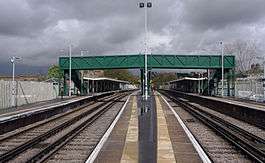Tulse Hill railway station
| Tulse Hill | |
|---|---|
 | |
 Tulse Hill Location of Tulse Hill in Greater London | |
| Location | Tulse Hill |
| Local authority | London Borough of Lambeth |
| Managed by | Southern |
| Station code | TUH |
| DfT category | D |
| Number of platforms | 4 |
| Fare zone | 3 |
| National Rail annual entry and exit | |
| 2004–05 | 0.950 million[1] |
| 2005–06 |
|
| 2006–07 |
|
| 2007–08 |
|
| 2008–09 |
|
| 2009–10 |
|
| 2010–11 |
|
| 2011–12 |
|
| 2012–13 |
|
| 2013–14 |
|
| Key dates | |
| 1868 | Opened (LBSCR) |
| 1869 | LCDR arrives |
| 1871 | Additional LBSCR line |
| Other information | |
| Lists of stations | |
| External links | |
| WGS84 | 51°26′24″N 0°06′18″W / 51.4399°N 0.1049°WCoordinates: 51°26′24″N 0°06′18″W / 51.4399°N 0.1049°W |
|
| |
Tulse Hill railway station is in the London Borough of Lambeth in south London, between railway bridges over the A205, South Circular Road and the A215, Norwood Road. It is served by both Southern and Thameslink, and it is in Travelcard Zone 3.
History
Tulse Hill station was opened in 1868 by the London, Brighton and South Coast Railway on their line from London Bridge. In 1869, this was joined by the London, Chatham and Dover Railway's "Metropolitan Extension" line to Holborn Viaduct. The LB&SCR's through line to Streatham and Wimbledon opened in 1871.
The station originally had a bowstring-arched iron and glass roof covering all four platforms. and the brick retaining walls of this structure survive. However, it appears that the roof was demolished as a precautionary measure following the collapse of a similar one at Charing Cross in 1905, and individual platform canopies were then introduced. These had no proper foundations, and gradually subsided until the last of the Edwardian canopies were replaced in the 1990s. Some modernisation of the station, including a new covered entrance on the east side, took place under the operator Southern, and ticket gates (funded by the Transport Department) were installed in 2009.
The station can accommodate eight-car trains; the complex sections of track at each end of the station and a large bridge which cannot be moved mean it cannot be extended to accommodate longer ones.[2]
Services
The typical off-peak service frequency is:
- 4 trains per hour to London Bridge via Peckham Rye (Southern)
- 2 trains per hour to West Croydon via Norbury (Southern)
- 2 trains per hour to Beckenham Junction via Crystal Palace (Southern)
- 2 trains per hour to St Albans via London Blackfriars (On Sundays, this service terminates at London Blackfriars) (Thameslink)
- 2 trains per hour to Luton via London Blackfriars (Thameslink)
- 2 trains per hour to Sutton via Mitcham Junction (and then clockwise around the Sutton loop) (Thameslink)
- 2 trains per hour to Sutton via Wimbledon (and then anticlockwise around the Sutton loop) (Thameslink)
There is also a single early-morning service to Brighton via East Croydon; this is complimented by two returning services from Brighton in the evening-peak to Bedford.
There is also a very limited "parliamentary" service from here to Streatham Hill via the Leigham spur - as of May 2016, one train per day calls on weekdays (westbound only) at 10.23am before travelling over this curve (having originated at London Bridge).[3] It has in the past operated in the other direction (such as in the 2005-6 timetable, when it ran as the 15.52 Streatham Hill to London Bridge).[4]
| Preceding station | |
Following station | ||
|---|---|---|---|---|
| Herne Hill | Thameslink Thameslink |
Streatham | ||
| North Dulwich | Southern Sutton & Mole Valley Lines |
Streatham | ||
| Southern Inner South London Line |
West Norwood | |||
| Southern London Bridge-Victoria Limited Service |
Streatham Hill | |||
Connections
London Buses routes 2, 68, 196, 201, 322, 415, 432, 468, P13 and school route 689, 690 and X68 and night routes N2 and N68 serve the station.
References
- 1 2 3 4 5 6 7 8 9 10 "Station usage estimates". Rail statistics. Office of Rail Regulation. Please note: Some methodology may vary year on year.
- ↑ Thameslink Programme
- ↑ GB eNRT May 2016 Edition, Table 173
- ↑ "PSUL 2006, England - Greater London"Passenger Services over Unusual Lines; Retrieved 24 May 2016
External links
| Wikimedia Commons has media related to Tulse Hill railway station. |
- Train times and station information for Tulse Hill railway station from National Rail